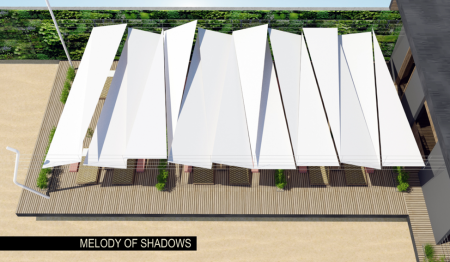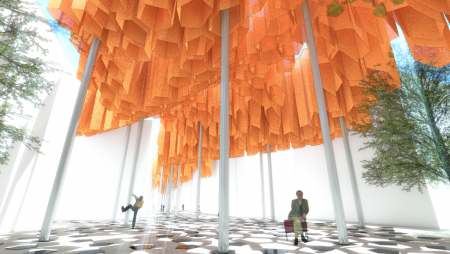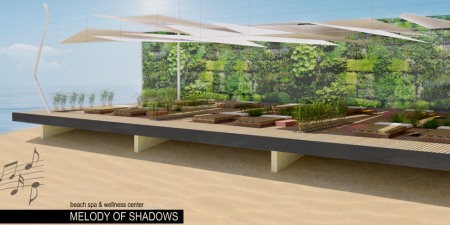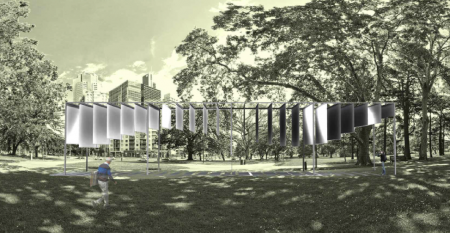Shade is Essential to Promoting Physical and Mental Wellness in Outdoor Spaces
Designing health into the spaces we use daily has become a hot topic in the architecture and design community as our lives become increasing defined by long daily commutes, sedentary desk jobs and binge-worthy television. We have written about how this concept applies to the use of exterior shade for buildings, but what does it mean for outdoor spaces?
Cities and towns across the nation have embraced the idea of outdoor amenities such as greenways, parks, pedestrian oriented shopping districts and even rooftop gardens as a way to promote health and wellness in their communities. While parks, greenways and urban trails have proven health benefits1, without adequate shading they can also carry health risks.
Shade is a key ingredient of outdoor spaces that promote health and wellness. It provides protection from the sun’s harmful ultraviolet (UV) rays and a break from hot temperatures, during exercise, play or quiet reflection.
Nature’s Role in Creating Wellness
Nature’s effect on our wellbeing is well documented.
A study titled, “The Health Benefits of Parks,” by Erica Gies for The Trust for Public Land, shows how access to greenways and parks results in increased in physical activity.1
In medical settings, views of nature have proven to aid the healing process. A 1984 study by Dr. Robert Ulrich provides research based evidence showing that views of nature shortened recovery times of post-surgical patients. Patients with rooms that had a view of trees healed on average a day faster, needed less pain medication and had fewer postsurgical complications than those in rooms with windows facing a brick wall.2
Another study by two University of Illinois at Urbana-Champaign researchers found that views of nature helped students’ ability to pay attention and recover from stressful situations.3
With mounting evidence of nature’s benefits to wellbeing, architects and landscape architects have begun to design healing gardens into medical centers, rooftop gardens onto office buildings, pocket parks into cities, pedestrian oriented shopping districts into small towns and nature trails on corporate campuses.
Fabric shade structures can enhance these natural spaces with the addition of color, artful design and intriguing shadow patterns.
New Thinking in Shade Design
In addition to protecting people from sunlight and the heat it generates, thoughtful shade design can also help tell a story. Each of the following shade design concepts tap into the power of shadows as shaped light to evoke an emotional response in addition to providing shelter from the sun.
A team of architects from Bosnia and Herzegovina envisioned a tension shade structure inspired by the musical notation for Claude Debussy’s Clair de Lune.
Melody of Shadows, a conceptual design by Zejd Kobilica, Jasmin Siro, Gorica Mehi and Ilma Kobilica, is a cable system forms the five-line staff with “notes” made of polygon and triangle fabric panels stretched taut on the cable system. It is designed to be incorporated into a spa or wellness center, perhaps in a music therapy area where clients can find restorative relaxation outside.
Shadows created as the sun moves throughout the day create the melody to be enjoyed by people below.

Shade Shape is conceptual shade design that uses changing shadows created by movement of the sun to tell a story. Created by Belgian architecture student Vânia Correia, Shade Shape consists of vertical fabric panels of different lengths mounted on a steel frame create a simple and light structure that provides shade, while allowing for cooling airflow.
Fabric panels give rhythm to open space and their shadows provide visual interest throughout the day as the sun changes position. The concept can easily be applied to different environments, such as an interior atrium or a courtyard.

Another shade design concept, Quasicrystal for Design, plays with shadow patterns and color, moving it into the realm of art installation. Created by Chilean architects Alberto Adolfo Fernandez Gonzalez and Carlos Benjamin Fernandez Gonzalez, the design incorporates hanging fabric tubes, clustered together over walkways in a pedestrian oriented shopping district to create a dappled shade effect.

Concepted as a shade solution for the Miami Design District to protect shoppers from the intense Miami sun and heat, the design complements the upscale shopping area’s art-oriented building facades, murals and sculptures. The architects intended to alter the way people perceived the space by creating shadows that would change as the fabric tubes move in the breeze and as the sun traverses the sky.

As these designs illustrate, by incorporating thoughtful, intentional shading, designers can ensure they create outdoor spaces that truly promote multiple levels of wellness: physical wellness through protection from sun and heat and mental wellness through artful shade structures with changing shadow patterns that provoke moments of reflection.
View more new thinking in shade design at futureofshade.com.
1 “The Health Benefits of Parks,” http://usahomepagewww.eastshorepark.org/HealthBenefitsReport_FINAL_010307.pdf
2 “View Through a Window May Influence Recovery from Surgery,” https://www.ncbi.nlm.nih.gov/pubmed/6143402
3 “Impact of Views to School Landscapes on Recovery from Stress and Mental Fatigue,” https://www.huffpost.com/entry/new-study-students-learn-_b_9143290

